Functional Medicine is an evolution in the practice of medicine that better addresses the healthcare needs of the 21st century.
It involves understanding the origins, prevention and treatment of complex chronic disease.
The general public is frustrated with the kind of healthcare it is receiving. The current paradigm is based on an acute care model that is centered on diagnosing and naming diseases and then treating the diagnosis with the suppression of symptoms using drugs and surgery. This often leads to a spiral of adverse effects and secondary new diseases and symptoms.
Doctors usually only have 10 minutes to spend with each patient, just enough time to fill out a prescription or refer them to yet another specialist. Each medical specialty is likened to the leaves and branches on a tree, which sees the signs and symptoms manifested by a patient as completely separate entities with no connection between them. Thus the patient is treated with a dizzying array of medications and tests dispensed by each specialist.
The aim of Functional Medicine is to get at the root cause of chronic disease plaguing our society, which is more like the roots of the tree rather than the branches, by using a personalized medicine approach that involves integrating the findings of genetic, environmental and lifestyle factors. In functional medicine these root causes are seen as imbalances, and the aim is restore balance within the patient using the most natural means possible, including, but not limited to, diet (using a functional nutrition approach), nutritional supplements, botanicals, lifestyle changes, and if necessary, in specific cases, the limited use of pharmaceutical medications. In Functional Medicine, the whole person is addressed, not just a collection of symptoms.
This approach requires the patient to be an active participant in their journey towards health and not a passive recipient, as in the "Fix me doc!" model. A partnership relationship is established between the physician and patient such that the clinician spends several hours listening to the patient, obtaining the details of their life story and timeline of health-impacting events, and helping the patient discover their dream or vision of their health. The story is told back to the patient so that there is a mutual understanding of the factors at play, and a plan of action is developed jointly. Each plan is individualized and personalized for that patient's particular genetics, biochemistry, physiology, personality, lifestyle and preferences. There is considerable and continued support for the implementation and reassessment of the plan through education and coaching. In this way, the patient takes an active and responsible role in achieving and maintaining their health goals.
The Functional Medicine Tree
The Functional Medicine Tree: Root imbalances cause signs and symptoms, which lead to organ system diagnoses. Functional Medicine aims to treat the roots of the the tree, not merely the branches and leaves.
Hallmarks of Functional Medicine:
Patient-centered, personalized care
Health seen as a positive vitality, not just the absence of disease
Prevention emphasized
"Upstream" causes searched for
Patient's history, physiology, lifestyle, genetics, mind, body, spirit, physical and social environment taken into account, ie. the whole person
Science and evidence-based
Integrates the best medical practices including nutrition, diet, exercise, cutting-edge laboratory testing, botanical medicines, supplements, detoxification programs and stress-management techniques; drugs used when necessary
Functional Medicine Uses A Systems-Biology Approach:
A key feature of Functional Medicine is the plotting of the patient's complex signs, symptoms and laboratory values onto the "Functional Medicine Matrix", seen below in the diagram.
This is a systems approach which aims to integrate the disparate information into groupings with similar underlying imbalances and pathogenesis, and allows the practitioner to more easily see the relationship between different systems, which form an interconnected web.
The 7 Core Clinical Imbalances which are assessed by the practitioner, include:
- Assimilation (digestion, absorption, microbiota/GI, respiration)
- Defense and Repair (immune function, inflammation, infection)
- Energy (mitochondrial function, energy regulation)
- Biotransformation and Elimination (detoxification/toxicity)
- Transport (cardiovascular and lymphatic systems)
- Communication (hormones, neurotransmitters)
- Structural Integrity (membranes, musculoskeletal)
Also on the "Matrix" are the Antecedents, Triggering Events and Mediators which play a role in causing, triggering or perpetuating the patient's imbalances, and Modifiable Lifestyle Factors, including Sleep and Relaxation, Exercise and Movement, Nutrition, Stress and Relationships. At the core of the Matrix is the patient's Mental, Emotional and Spiritual balance.
The Functional Medicine Matrix
Functional Medicine Timeline:
During the initial interview, the practitioner plots the antecedents, triggers, mediators, prenatal history, medical and surgical history, diseases, treatments, signs and symptoms, stressors, life-changing events, and any other pertinent information on a timeline according to the date or age of the patient at the time of the occurrence. This allows both the patient and the practitioner to see potential cause and effect relationships of the various events of the patient's life and how the "story" of the patient's present condition may have unfolded. This can lead to profound insights and realizations that may have direct clinical application. It is often very satisfying to the patient to finally understand that their symptoms did not come "out of nowhere" and to see the evolution of their development. If the patient can see how they "got into this mess", they can plot a path out of it. The patient often connects with a new-found sense of hope and motivation.
Functional Medicine Timeline





